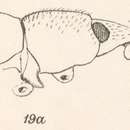Description
provided by INOTAXA archive
♂. Oblong, subfusiform, convex, black, the tibiæ, tarsi, and base of the antennæ ferruginous in one example; variegated with a dense clothing of whitish and fuscous scales, the dark scales on the prothorax wholly condensed into two broad narrowly divided vittæ on the disc, and those on the elytra asymmetrically confluent, the scales on the scutellum, legs, and under surface whitish, with a faint cupreous tint, the ventral segments with intermixed decumbent white hairs; the upper surface also set with very short, curled, fine, semierect setæ. Rostrum and antennæ as in E. conicicollis. Prothorax transverse, gradually narrowing from the base, coarsely, closely punctate. Scutellum strongly transverse. Elytra longer than in E. conicicollis, and more developed at the sides inferiorly below the humeri (the lower margin appearing more strongly sinuate when the insect is viewed in profile); coarsely punctate-striate, the interstices convex (when the scales are removed). Ventral segments 1 and 2 very broadly hollowed down the middle. All the tibiæ unguiculate.
Length 4½, breadth 1 9/10—2 millim.
- license
- cc-by-3.0
- copyright
- Biologia Centrali-Americana
Distribution
provided by INOTAXA archive
Hab.MEXICO, Yucatan (Mus. Brit.).
- license
- cc-by-3.0
- copyright
- Biologia Centrali-Americana
Physical description
provided by INOTAXA archive
Two males: one, without definite locality, in very fresh condition, and labelled with the MS. name of Jekel's used above; the other, from Yucatan, completely abraded, and showing how different the sculpture really is when the scales are removed. This species differs from the maculate form of E. conicicollis in having the prothorax less widened towards the base and sharply fusco-vittate on the disc; the elytra more elongate, more developed inferiorly below the humeri, and with the lower margin strongly sinuate; and the first ventral segment more broadly excavate, and the fifth without numerous erect hairs, in the male.
- license
- cc-by-3.0
- copyright
- Biologia Centrali-Americana

